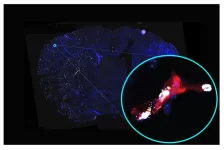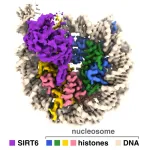(Press-News.org) **Note: the release below is from the European Congress of Clinical Microbiology & Infectious Diseases (ECCMID 2023, Copenhagen, 15-18 April). Please credit the conference if you use this story**
A genetic study analysing the microbiome (bacteria in the gut) of a large nationally representative sample of the Finnish population finds that geographic, demographic, diet, and lifestyle factors are driving the spread of antibiotic resistance in the general population.
The most comprehensive study of its kind by Dr Katariina Pärnänen from the University of Turku in Finland and colleagues, being presented at this year’s European Congress of Clinical Microbiology & Infectious Diseases (ECCMID) in Copenhagen, Denmark (15-18 April), highlights the urgent need for targeted interventions to reduce antibiotic resistance tailored to different demographics and lifestyles.
Antibiotic-resistant bacteria can spread through healthy adult populations and go largely unnoticed. Antimicrobial resistance poses a significant threat to humanity, and has become a leading cause of death worldwide, involved in an estimated 5 million deaths in 2019 and estimated to be the direct cause of 1.27 million deaths [1]. Estimates suggest that antimicrobial resistance will overtake cancer as the leading cause of death worldwide by 2050 [2].
Despite the remarkable efforts to map the overall composition and health associations of the gut microbiome over the last decade, a deeper understanding of the factors driving the distribution of antimicrobial resistance within the general population is urgently needed.
To find out more, researchers investigated the extent to which demographic, dietary, health and geographic factors influence the abundance of antibiotic resistance genes (ARGs) in gut metagenome faecal samples from 7,098 symptomless adults taking part in the national FINKRISK study—a large representative Finnish population survey carried out every 5 years since 1972.
The FINRISK project collects extensive health and lifestyle data, including major diagnoses, blood measurements, habitual diet, and prescription drug use, that are proxies for the three ecological mechanisms that influence ARG abundance—acquisition of external ARGs from food; host health status (endemic resistance); and drug-mediated selection of resistant bacteria.
Researchers used shotgun metagenomes (untargeted genetic sequencing of all bacteria living in the gut) to examine the associations between participants’ antibiotic resistance gene load, diversity, and composition and geography, demography, lifestyle, and health factors.
As expected, the analyses found that antibiotic use was linked to higher ARG loads, but other drug classes, such as psycholeptic drugs (e.g., opioids and barbiturates), were also associated with higher abundance of ARGs.
The analyses also found that more frequent raw vegetable and poultry consumption (both foods containing high quantities of resistant bacteria) was associated with higher ARG loads and diversity.
What’s more, ARG loads, composition, and diversity were also associated with geography. For example, people living in western Finland had a higher abundance and more diverse ARGs than those living in the east. And higher population density was also associated with higher ARG load and diversity.
Interestingly, ARG loads had clear variation according to demographics, with women and participants on higher incomes having more resistance genes.
“Our findings clearly show that geography, demographics, and diet play an underappreciated role in antibiotic resistance,” says Dr Pärnänen. “This has important implications for the antibiotic resistance crisis as more and more people are living in densely populated areas and cities and are able to buy more expensive types of foods, such as meat, and fresh produce, and also medication. Reducing or preventing the spread of antimicrobial resistance will require action plans at national levels that go beyond regulating the misuse of antibiotic prescriptions.”
For interviews with the report authors, please contact Dr Katariina Pärnänen, University of Turku, Finland E) katariina.parnanen@utu.fi T) +35 8400 664 640
Alternative contact in the ECCMID Press Room: Tony Kirby T) + 44(0)7834 385827 E) tony@tonykirby.com
Notes to editors:
[1] Global burden of bacterial antimicrobial resistance in 2019: a systematic analysis - The Lancet
[2] 160525_Final paper_with cover.pdf (amr-review.org)
The authors declare no conflicts of interest.
This research was supported in part by grants from the Finnish Foundation for Cardiovascular Research, the Emil Aaltonen Foundation, the Alhopuro foundation, the Paavo Nurmi Foundation, the Urmas Pekkala Foundation, the Finnish Medical Foundation, the Academy of Finland and the National Institutes of Health. Additional support was provided by Illumina Inc. and Janssen Pharmaceutica through their sponsorship of the Center for Microbiome Innovation at UCSD. Computation was done at CSC, the IT centre for Scientific computing.
This press release is based on abstract 04221 at the European Congress of Clinical Microbiology & Infectious Diseases (ECCMID) annual meeting. The material has been peer reviewed by the congress selection committee. There is no full paper available at this stage and the work has not yet been submitted to a medical journal for publication.
END
Major genetic study reveals how antibiotic resistance varies according to where you live, demographics, and diet
Women and those on higher incomes found to have more antibiotic resistance genes; living in cities also fuels resistance.
2023-04-15
ELSE PRESS RELEASES FROM THIS DATE:
UK-Portuguese study shows antibiotic-resistant “superbugs” are being passed between dogs and cats and their owners, study strongly suggests
2023-04-15
**Note: the release below is from the European Congress of Clinical Microbiology & Infectious Diseases (ECCMID 2023, Copenhagen, 15-18 April). Please credit the conference if you use this story**
Evidence that multidrug-resistant bacteria are being passed between pet cats and dogs and their owners will be presented at this year’s European Congress of Clinical Microbiology & Infectious Diseases (ECCMID) in Copenhagen, Denmark (15-18 April).
Six pets in Portugal and one in the UK were carrying antibiotic-resistant bacteria similar to those found in their owners, a Portuguese study found.
The finding underlines the importance ...
Study of cerebral blood vessels uncovers potential new drug targets for treating stroke
2023-04-14
Strokes cause numerous changes in gene activity in affected small blood vessels in the brain, and these changes are potentially targetable with existing or future drugs to mitigate brain injury or improve stroke recovery, according to a study led by Weill Cornell Medicine scientists.
In the study, which appears Apr. 14 in the Proceedings of the National Academy of Sciences, the researchers performed a comprehensive survey, in a preclinical model, of gene activity changes in small blood vessels in the brain following stroke. Comparing these changes to those that have been recorded in stroke patients, they catalogued hundreds ...
Tracking a new path to octopus and squid sensing capabilities
2023-04-14
Along their eight arms, octopuses have highly sensitive suckers that allow methodical explorations of the seafloor as they search for nourishment in a “taste by touch” approach. Squids, on the other hand, use a much different tactic to find their next meal: patiently hiding until they ambush their prey in swift bursts.
In a unique analysis that provides a glimpse into the origin stories of new animal traits, a pair of research studies led by University of California San Diego and Harvard University scientists has traced the evolutionary adaptations of octopus and squid sensing capabilities. The studies, featured on ...
Trees in savanna areas of Cerrado produce three times more bark than species in forest areas
2023-04-14
In tropical regions of the planet, savannas and forests often coexist in the same area and are exposed to the same climate. An example is the Cerrado, a Brazilian biome that includes several types of vegetation, from broad-leaved and sclerophyllous in dense woodland or shrubland (cerrado sensu stricto) to semi-evergreen in closed-canopy forest (cerradão), as well as grassland with scattered shrubs (campo sujo) and even semi-deciduous seasonal forest.
Areas of cerradão develop in the absence of fire, in both poor and moderately fertile soil (dystrophic to mesotrophic).
This coexistence intrigues botanists and ecologists ...
Wayne State researcher receives $1.95 million NIH grant to study impact of inositol homeostasis on essential cellular functions
2023-04-14
DETROIT – A researcher from Wayne State University’s Department of Biological Sciences has received a five-year, $1.95 million grant from the National Institute of General Medical Sciences of the National Institutes of Health to identify mechanisms that regulate inositol synthesis in mammalian cells and determine the cellular consequences of inositol depletion.
Inositol is a type of sugar that is essential for the viability of eukaryotic cells. Myo-inositol is the precursor of all inositol compounds, which play pivotal roles in cell signaling and metabolism. Consistent with its importance, a disturbance of inositol homeostasis ...
Head and neck, breast cancer research highlights University of Cincinnati AACR abstracts
2023-04-14
University of Cincinnati Cancer Center researchers will present more than a dozen abstracts at the American Association for Cancer Research Annual Meeting 2023, held in Orlando, Florida, April 14-19, including findings that could advance treatments for head and neck and breast cancers.
Enzyme shows promise as target to treat HPV negative head and neck cancer
Vinita Takiar’s lab in UC’s Department of Radiation Oncology studies how to improve radiation therapy for head and neck cancer patients.
Julianna Korns, a doctoral student working in Takiar’s lab, and her colleagues study an enzyme called Plk1 that allows healthy cells to divide ...
Scientists develop new way to measure wind
2023-04-14
Wind speed and direction provide clues for forecasting weather patterns. In fact, wind influences cloud formation by bringing water vapor together. Atmospheric scientists have now found a novel way of measuring wind – by developing an algorithm that uses data from water vapor movements. This could help predict extreme events like hurricanes and storms.
A study published by University of Arizona researchers in the journal Geophysical Research Letters provides, for the first time, data on the vertical distribution of horizontal winds ...
Ancient DNA reveals the multiethnic structure of Mongolia’s first nomadic empire
2023-04-14
Long obscured in the shadows of history, the world’s first nomadic empire - the Xiongnu - is at last coming into view thanks to painstaking archaeological excavations and new ancient DNA evidence. Arising on the Mongolian steppe 1,500 years before the Mongols, the Xiongnu empire grew to be one of Iron Age Asia’s most powerful political forces - ultimately stretching its reach and influence from Egypt to Rome to Imperial China. Economically grounded in animal husbandry and dairying, the Xiongnu were famously nomadic, building their empire on the backs of horses. ...
2022 Tongan volcanic explosion was largest natural explosion in over a century, new study finds
2023-04-14
The 2022 eruption of a submarine volcano in Tonga was more powerful than the largest U.S. nuclear explosion, according to a new study led by scientists at the University of Miami Rosenstiel School of Marine, Atmospheric, and Earth Science and the Khaled bin Sultan Living Oceans Foundation.
The 15-megaton volcanic explosion from Hunga Tonga-Hunga Ha'apai, one of the largest natural explosions in more than a century, generated a mega-tsunami with waves up to 45-meters high (148 feet) along the coast of Tonga’s Tofua Island and waves up to 17 meters (56 feet) on Tongatapu, ...
How does an aging-associated enzyme access our genetic material?
2023-04-14
UNIVERSITY PARK, Pa. — New research provides insight into how an enzyme that helps regulate aging and other metabolic processes accesses our genetic material to modulate gene expression within the cell. A team led by Penn State researchers have produced images of a sirtuin enzyme bound to a nucleosome—a tightly packed complex of DNA and proteins called histones—showing how the enzyme navigates the nucleosome complex to access both DNA and histone proteins and clarifying how it functions in humans and other animals.
A paper describing the results appears April 14 in the journal ...
LAST 30 PRESS RELEASES:
Scientists to ‘spy’ on cancer- immune cell interactions using quantum technology breakthrough
Tech savvy users have most digital concerns
Making lighter work of calculating fluid and heat flow
Normalizing blood sugar can halve heart attack risk
Lowering blood sugar cuts heart attack risk in people with prediabetes
Study links genetic variants to risk of blinding eye disease in premature infants
Non-opioid ‘pain sponge’ therapy halts cartilage degeneration and relieves chronic pain
AI can pick up cultural values by mimicking how kids learn
China’s ecological redlines offer fast track to 30 x 30 global conservation goal
Invisible indoor threats: emerging household contaminants and their growing risks to human health
Adding antibody treatment to chemo boosts outcomes for children with rare cancer
Germline pathogenic variants among women without a history of breast cancer
Tanning beds triple melanoma risk, potentially causing broad DNA damage
Unique bond identified as key to viral infection speed
Indoor tanning makes youthful skin much older on a genetic level
Mouse model sheds new light on the causes and potential solutions to human GI problems linked to muscular dystrophy
The Journal of Nuclear Medicine ahead-of-print tip sheet: December 12, 2025
Smarter tools for peering into the microscopic world
Applications open for funding to conduct research in the Kinsey Institute archives
Global measure underestimates the severity of food insecurity
Child survivors of critical illness are missing out on timely follow up care
Risk-based vs annual breast cancer screening / the WISDOM randomized clinical trial
University of Toronto launches Electric Vehicle Innovation Ontario to accelerate advanced EV technologies and build Canada’s innovation advantage
Early relapse predicts poor outcomes in aggressive blood cancer
American College of Lifestyle Medicine applauds two CMS models aligned with lifestyle medicine practice and reimbursement
Clinical trial finds cannabis use not a barrier to quitting nicotine vaping
Supplemental nutrition assistance program policies and food insecurity
Switching immune cells to “night mode” could limit damage after a heart attack, study suggests
URI-based Global RIghts Project report spotlights continued troubling trends in worldwide inhumane treatment
Neutrophils are less aggressive at night, explaining why nighttime heart attacks cause less damage than daytime events
[Press-News.org] Major genetic study reveals how antibiotic resistance varies according to where you live, demographics, and dietWomen and those on higher incomes found to have more antibiotic resistance genes; living in cities also fuels resistance.






